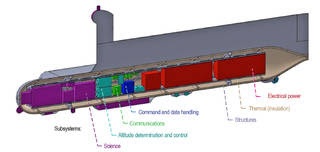(1) retiring risks found in the Phase I design,
(2) gathering new Kraken Sea observations by Cassini, and
(3) further defining science goals and instruments to fulfill them; each of these tasks will feed into two COMPASS design sessions.All of these products should ready the Titan Submarine (Titan Sub) concept to a confidence level that allow further NASA investment. The major risks found in the Phase I conceptual design center around vehicle operations in a liquid hydrocarbon sea. Basic physics questions of operating in this cryogen need to be answered. Cryogenic experts at the NASA Glenn Research Center will develop models to explore mixtures and pressures of cryogens and gases and how they would react with a warm submarine. Results from these models will be used to refine the ballast and propulsion system conceptual designs as well as feed into development of a hydrodynamic fluid models at the Pennsylvania State University Applied Research Laboratory for evaluating the conceptual design.
Cassini continues to observe both the constituents (remotely) and the depth of the northern Titan Seas. Up-to-date data will be gathered and used as inputs for the modeling mentioned above. These data, along with the above analysis results, will be used to refine the science goals, concept of operations, and instrument suite for the Titan Sub. These activities will be led by the Johns Hopkins University Applied Physics Laboratory.
The Phase II efforts will be strengthened by workshops at selected science and cryogenic conferences that will include scientists, cryogenic engineers (including the liquid natural gas industry) respectively, as well as NASA project planners to review the Titan Sub concept and add direction and experience to the challenges it faces. The results of both the above efforts will feed into a COMPASS current engineering design run to update the current Titan Sub conceptual design to mature the concept.
Launch and delivery options will be explored (in Phase I funds were not sufficient to design more than the Sub itself) on how to deliver this long cylindrical submarine. Risks of an exposed phased-array antenna to communicate directly back to Earth will also be explored. A second COMPASS run will develop a Titan Sub that would be delivered as part of an orbiter system. The presence of an orbiter would greatly simplify several aspects of the submarine design, especially delivery and communications.
The proposed ~1-tonne vehicle, with a radioisotope Stirling generator power source, would be delivered to splashdown circa 2040, to make a ~90-day, ~2000km voyage of exploration around the perimeter, and across the central depths of, Kraken on Saturn’s moon Titan.
After initial trials to determine dynamic characteristics in-situ and verify guidance/ performance models, the vehicle would begin its scientific traverse. Navigation underway between communication fixes would be inertial, supplemented by acoustic doppler measurements. Most of the available ~1kW power is used alternately for submerged propulsion at up to ~1 meter / second, and for surfaced communication to Earth (roughly 16 hours per day). During northern summer (Titan’s year is 29.5 Earth years long) Earth is continuously visible from Titan’s arctic, although from some locations (Kraken sprawls from about 60 to 80o N latitude) Earth would be below the horizon for a few days at a time. The vehicle would observe – and perhaps ultimately exploit – tidal currents in the sea, which follow a cycle once per Titan day, or 16 Earth days. When surfaced, as well as communicating with Earth, the vehicle would use a mast-mounted camera to observe the sea state and shoreline landscape, and would record meteorological observations. Measurement of the trace organic components of the sea, which perhaps may exhibit prebiotic chemical evolution, will be an important objective, and a benthic sampler would acquire and analyze sediment from the seabed

Brian Wang is a Futurist Thought Leader and a popular Science blogger with 1 million readers per month. His blog Nextbigfuture.com is ranked #1 Science News Blog. It covers many disruptive technology and trends including Space, Robotics, Artificial Intelligence, Medicine, Anti-aging Biotechnology, and Nanotechnology.
Known for identifying cutting edge technologies, he is currently a Co-Founder of a startup and fundraiser for high potential early-stage companies. He is the Head of Research for Allocations for deep technology investments and an Angel Investor at Space Angels.
A frequent speaker at corporations, he has been a TEDx speaker, a Singularity University speaker and guest at numerous interviews for radio and podcasts. He is open to public speaking and advising engagements.




